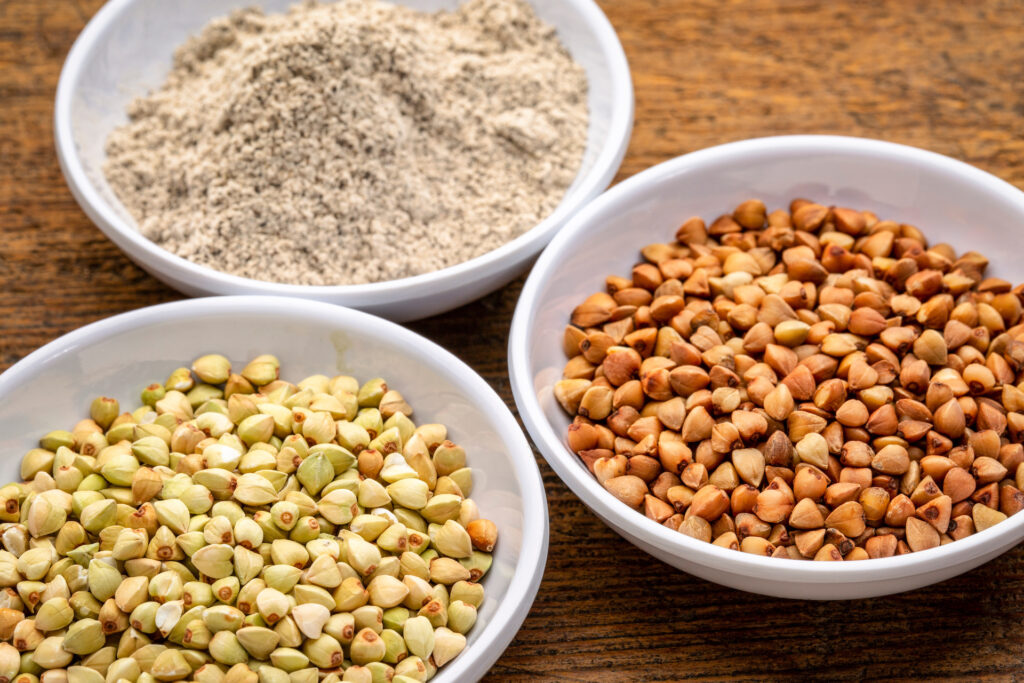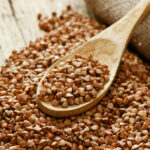This post may contain affiliate links. Please see our disclosure for more information.
Don’t be deceived by its name. Buckwheat is an entirely gluten-free whole grain that is decidedly more delicious than wheat—once you get used to its earthy, nutty taste.
Triangular in shape, buckwheat is sold in two main forms: groats and kasha.
Jump to Recipe
Groats are hulled, and light yellowy-beige to light green in color.
Kasha is toasted groats, and will be medium brown to reddish in color.
Roasting amplifies the flavor and aroma and reduces the cooking time by about half. I also feel that it improves the texture.
Groats tend to be sticky and gloppy, while kasha is light and fluffy.
Now, be aware that you may sometimes find toasted buckwheat labelled “groats.”
That’s because this groats and kasha distinction is an American thing.
In Russia and other Eastern European countries where buckwheat is a staple food, “kasha” simply means porridge, and buckwheat is almost always sold in the toasted form.
Where to buy
Finding an affordable source of toasted buckwheat (kasha) can be a challenge, since it is not popular in the United States.
At natural food stores you will most likely get untoasted groats from both Bob’s Red Mill and Eden Foods.
To get the toasted kasha called for in this recipe, you will have to look online, or find a specialty grocer. Unfortunately, online sources are a little more costly due to the rarity.
After searching in vain for a Russian grocery store in my area where I could buy buckwheat at a good price, I remembered my local Mediterranean speciality store.
Turns out the store, Yaranush, is owned by Armenians, and they stock Armenian products.
Buckwheat hails from Russia, and so anywhere Russians have influence, you will find it at speciality stores that cater to the Russian diaspora.
Armenia is one of the former USSR countries, along with Ukraine, Belarus, Latvia, Lithuania, Estonia, Moldova, Armenia, Azerbaijan, Georgia, Kazakhstan, Kyrgyzstan, Tajikistan, Turkmenistan and Uzbekistan.
Now I’m dreaming of my next visit to Yaranush, where I’ll buy baklava and buckwheat …
Purchase buckwheat online
Amazon provides a number of good options to buy toasted Russian buckwheat online, and it makes sense to buy a larger quantity since it will store in the pantry for up to 2 years.
The Russian buckwheat my friend gave me: Altayskaya Skazka Buckwheat
Another Russian buckwheat: by Uvelka
Another Russian buckwheat with high ratings: Russkoe Pole Buckwheat
Nutrition
Buckwheat is high in antioxidants, minerals, and fiber, AND it contains all nine essential amino acids, which means it is a complete vegetarian protein.
One cup of cooked buckwheat contains 4.5g of dietary fiber, 5.7g of protein, 33g carbohydrate, and 7.5 percent of the recommended daily intake of iron.
It is also a source of magnesium, manganese, phosphorous, selenium, calcium, vitamin D, and zinc.
According to healthline, consumption of buckwheat is associated with lower LDL (bad) cholesterol, and a higher ratio of HDL (good) cholesterol.
Ayurveda’s view
Buckwheat and warming and drying, making it perfect for individuals looking for a lighter and more easily digested alternative to wheat.
John Immel, Ayurvedic practitioner and director of the Joyful Belly School of Ayurveda, says that buckwheat boosts the metabolism, and “may be ideal for chronic weakness due to low metabolism associated with aging” or those suffering from chronic disease.
Buckwheat is very popular in Russia, and other cold regions of the world, which makes sense considering its warming quality.
However, Traditional Chinese Medicine and macrobiotics speak about buckwheat’s warming action in terms of supporting metabolism. This is very different from the stimulating kind of heat you’d get from something like a chili.
Who is buckwheat good for?
- Anyone searching for a gluten-free alternative to wheat.
- Anyone working to heal an imbalance of cold, such as that associated with weak digestion.
- Anyone with too much internal water, mucus, and/or congestion.
- Anyone with loose or watery stools will also find buckwheat supportive due to the pseudo-grain’s drying astringent quality.
- Anyone who is chronically weak due to aging or chronic disease.
How to cook
When cooked, the individual buckwheat grains will remain separate and fluffy. The grains are nice and soft, while still retaining a pleasing soft chew from the fibrous exterior.
However, be aware that when overcooked, buckwheat can turn to mush and become gummy or sticky. Not so pleasant.
How to avoid overcooking buckwheat?
Use a ratio of 1 cup buckwheat to 1 1/2 cups water.
Soak the buckwheat first for at least 2 hours for improved digestibility.
I love adding onions and butter to the buckwheat. The technique is very similar to cooking a pilaf or rice and beans.
You’ll start with the butter and onions, then add the water, soaked grains, and a bit of salt, Bring to a boil, reduce heat to a simmer, and cover.
It is very much like cooking rice. Set a timer for 10 minutes, and you’re done.
Recipe variations
- When adding the onions, you could also add extra vegetables, such as frozen peas, chopped carrots, and/or cabbage.
- Use as a meat substitute in tacos etc.
- This would be lovely with grated beets and/or chopped apples.
- Turn buckwheat into a porridge by adding more water, cinnamon, and/or milk.
How to roast buckwheat groats
If you find yourself with buckwheat groats and want to turn it into kasha, you can easily do so, however this method will not give the same result as the traditional roasted buckwheat.
At first, I had confusion over why this would be the case. I could not understand what accounted for the difference. Then I read that during the preparation process, Russian buckwheat is steamed prior to roasting. This appears to make all the difference.
To roast buckwheat yourself, add dry groats to a saucepan or skillet on medium heat. Stir frequently for about 5-10 minutes, until the grains turn brownish-red. When you see steam, it’s done.
Do not soak your hand-roasted buckwheat, and careful not to overcook to avoid getting mush.

Recipe for Buckwheat Kasha with Butter & Onions
Equipment
- Small saucepan – 1.75 qt.
Ingredients
- 2 teaspoons butter or ghee
- 1/2 cup onion finely chopped
- 2/3 cup water
- 1/4 teaspoon salt
- 1/3 cup buckwheat kasha soaked and rinsed
Instructions
- Soak buckwheat for about 2 hours. (Optional)
- Heat butter or ghee in a small saucepan on medium heat. Add chopped onion and stir. Continue to cook until the onion is starting to brown.
- Add water and salt and bring to a boil.
- Add buckwheat and stir. Reduce heat to low, cover, and set a timer for 10 minutes.
- Turn off the heat, and let stand covered for 5-10 minutes. Fluff with a fork and serve.
Notes
Variations
- When adding the onions, you could also add extra vegetables, such as frozen peas, chopped carrots, and/or cabbage.
- This would be lovely with grated beets and/or chopped apples.
- Turn buckwheat into a porridge by adding more water, cinnamon, and/or milk.
